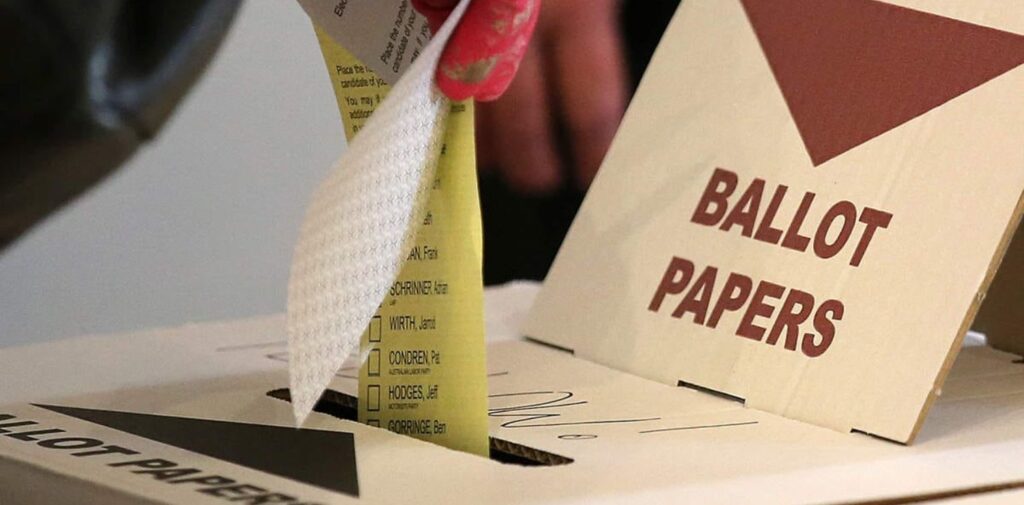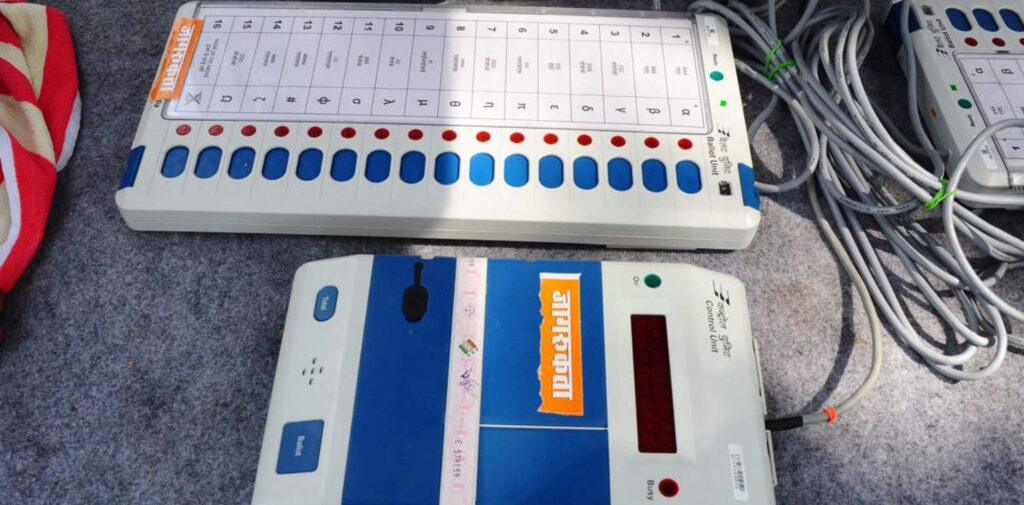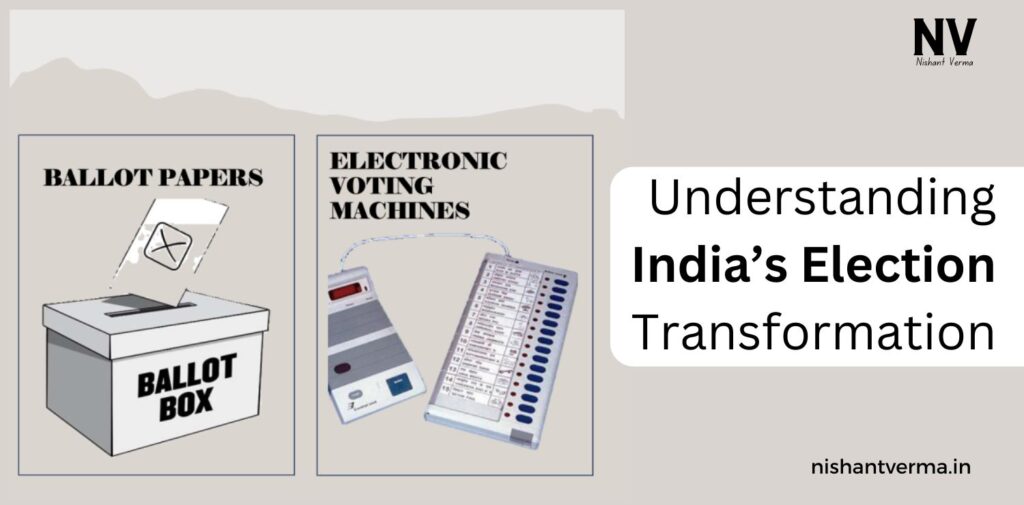Elections are the lifeblood of any democracy. In India, a country known for its massive voter base and complex electoral processes, ensuring free, fair, and efficient elections is a monumental task. Over the years, the Election Commission of India (ECI) has made several technological advancements to improve the electoral process. One of the most significant innovations was the transition from ballot papers to Electronic Voting Machines (EVMs). While this shift was gradual and faced both praise and criticism, it fundamentally changed the way elections are conducted in India. Let’s explore the reasons behind the transition of Ballot Paper to EVMs, the impact it has had, and the debate it has sparked.
The Old System: Ballot Papers
Before the introduction of EVMs, elections in India were conducted using paper ballots. Each voter received a ballot paper listing the names and symbols of the candidates. Voters would mark their choice on the ballot paper, fold it, and drop it into a sealed ballot box. While this system was straightforward, it had several limitations.

Challenges with Ballot Paper Voting:
- Human Error: Marking the ballot could sometimes lead to confusion, especially for less literate voters, resulting in many invalid or incorrectly marked votes.
- Rigging and Tampering: Ballot boxes were vulnerable to tampering. Incidents of booth capturing, where goons would seize control of voting booths and stuff ballot boxes with fake votes, were reported in some parts of the country.
- Slow Counting Process: Counting ballot papers was a tedious and time-consuming process. It often led to delays in the declaration of election results, which could stretch for days.
- Environmental Concerns: The sheer volume of paper required for elections posed environmental concerns, especially in a country as large as India.
- Logistics and Security: Transporting and safeguarding millions of ballot papers across the length and breadth of the country was an enormous logistical challenge for the Election Commission.
The Introduction of EVMs: A Step Toward Modernization
To overcome the shortcomings of ballot paper voting, the Election Commission began experimenting with Electronic Voting Machines in the 1980s. By the 2004 General Elections, EVMs were used nationwide. These machines replaced the paper-based system with a digital voting process. Voters would press a button corresponding to their preferred candidate, and the vote would be recorded electronically.

Advantages of EVMs Over Ballot Paper Voting:
- Faster Results: One of the biggest advantages of EVMs is the speed of counting votes. Once the polls close, election officials can retrieve the results within hours, leading to a quicker declaration of winners.
- Elimination of Invalid Votes: EVMs do away with issues of invalid or unclear votes. Since voters press a button to cast their vote, the chances of incorrectly marked votes are minimized.
- Reduced Electoral Fraud: EVMs have built-in safeguards against rigging. They are stand-alone devices, not connected to any external network, making them less susceptible to hacking. Each machine also has a tamper-proof seal and multiple security checks.
- Cost Efficiency: Over time, EVMs have proven to be more cost-efficient than paper ballots. The machines can be reused in multiple elections, reducing the recurring costs of printing millions of ballots.
- Environmental Benefits: EVMs have significantly reduced the use of paper in elections, contributing to environmental conservation efforts.
Key Features of EVMs
The EVM consists of two units: the control unit and the balloting unit. The control unit is operated by the polling officer, and the balloting unit is where the voter registers their vote by pressing the button next to their chosen candidate’s name and symbol. The machine is designed to be simple, secure, and user-friendly, ensuring that even voters with limited technological experience can cast their votes with ease.
Voter Verified Paper Audit Trail (VVPAT)
To increase transparency, the Election Commission introduced the Voter Verified Paper Audit Trail (VVPAT) system alongside EVMs in 2013. The VVPAT generates a paper slip that shows the voter their choice for a few seconds before it drops into a sealed box. This provides a physical record of the vote and acts as a safeguard against potential malfunctions or fraud in the EVM.

Reasons Behind the Shift of Ballot Paper to EVMs
The decision to shift from ballot papers to EVMs was not taken lightly. Several factors contributed to the Election Commission’s choice to modernize the voting process:
- Reducing Electoral Malpractice: The prevalence of electoral malpractices like booth capturing, tampering with ballot boxes, and stuffing fake votes was a major concern with the paper ballot system. EVMs, with their tamper-proof design and stringent security protocols, helped reduce such malpractices significantly.
- Increasing Efficiency: With the ballot paper system, elections were a slow process. From casting votes to counting them, every step took time. EVMs have streamlined the entire process, making elections faster and more efficient. The time taken for counting votes has reduced drastically, with results now available within hours instead of days.
- Addressing Voter Error: In the ballot paper system, many votes were deemed invalid due to incorrect markings by voters. EVMs eliminate this issue, as voters simply press a button to cast their vote, minimizing human error.
- Meeting the Demands of a Growing Voter Base: India’s population has been growing rapidly, and with it, the voter base. Conducting elections for such a large number of people requires a system that can handle the sheer volume of votes efficiently. EVMs have helped the Election Commission manage elections with millions of voters in a much more streamlined manner.
- Environmental Concerns: Using paper ballots in a country with over 900 million eligible voters required vast amounts of paper. EVMs have helped reduce the environmental impact of elections by cutting down on the need for paper.
Debate Surrounding EVMs: Addressing Concerns and Criticisms
While EVMs have largely been hailed as a positive step, they have not been without controversy. Some political parties and individuals have raised concerns about the machines’ integrity, claiming that they can be tampered with or hacked. In particular, after some election results, parties that performed poorly have questioned the accuracy of EVMs.
- Allegations of EVM Tampering: Several political parties have, at times, claimed that EVMs were rigged to manipulate results. However, the Election Commission and several independent experts have consistently maintained that EVMs are secure and tamper-proof. EVMs in India are not connected to the internet, which reduces the risk of hacking.
- Demand for Paper Trails: To address concerns about the lack of transparency in EVM voting, the VVPAT system was introduced. With VVPAT, voters can physically verify that their vote was cast for the intended candidate. The paper trail ensures that, in the case of any disputes, the votes can be cross-verified with the paper slips.
- Technological Challenges: Some argue that in a country with varying levels of technological literacy, the shift to EVMs may alienate older or less tech-savvy voters. However, the Election Commission has worked to simplify the machines, making them user-friendly for all voters.
Conclusion: EVMs—A Step Forward for Indian Democracy
The shift from ballot papers to EVMs marks a significant transformation in the way India conducts its elections. While the transition has not been without challenges and criticisms, the overall impact has been overwhelmingly positive. EVMs have made elections faster, more efficient, and more secure, helping the world’s largest democracy manage its massive electoral processes smoothly.
In the years to come, as India continues to modernize, the Election Commission will likely explore further technological innovations to ensure that elections remain free, fair, and transparent. However, for now, EVMs stand as a testament to India’s ability to embrace change while preserving the core values of its democratic system.




